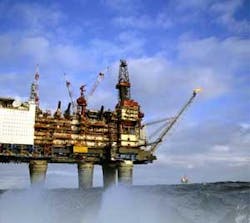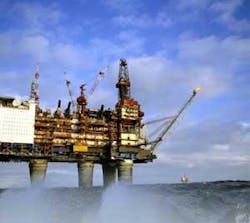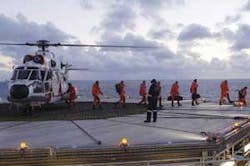Norway’s StatoilHydro emerges as top global deepwater operator
Don Stowers, Editor, OGFJ
Photo courtesy of Øyvind Hagen/StatoilHydro
Until their merger in October 2007, Statoil and Hydro were two of the most prominent players in the Norwegian oil industry going back to the early 1970s. Both made key contributions towards developing Norway into a modern industrial nation. The merger into StatoilHydro created a dynamic, global oil and gas company, one that is especially noted for its innovations and technical expertise in the offshore realm. The company is the world’s largest offshore operator in waters more than 100 meters deep.
In Statoil’s next annual general meeting, scheduled for May 19, the company will discuss a proposal for a new name and logo. Changing the name of the company had been planned at the time of the merger, but StatoilHydro was chosen as an interim name. The Norwegian Ministry of Petroleum and Energy has stated that the new company name must include “Statoil,” either alone or as the main part of any new name. The Norwegian government is the primary owner of StatoilHydro, although the company’s stock is publicly traded on both the Oslo Stock Exchange and the New York Stock Exchange. It is likely that the new firm name will be Statoil ASA, according to company officials, and the change will take effect on Nov. 1.
When the board next meets, it will also consider a change in bylaws that will reflect the company’s new strategic focus, which includes a gradual increase in renewable energy as part of its portfolio. Like many multi-national energy companies, StatoilHydro is getting greener.
StatoilHydro’s New Energy business unit is responsible for the company’s effort within renewable power production, sustainable fuel production, CO2 management, and technology management.
In addition to the activities of the New Energy business unit, both StatoilHydro Retail and StatoilHydro R&D have extensive activities within renewable technologies, sustainable fuels, and CO2 management.
As far as greenhouse gases are concerned, the company already has implemented carbon injection and storage at its Snøhvit field in the Barents Sea. Instead of emitting carbon dioxide resulting from the well stream that comes from the gas field into the air, the CO2 is reinjected into the ground and stored in a formation that lies beneath Snøhvit’s gas-bearing formations.
“By reinjecting CO2 beneath the seabed we strongly reduce greenhouse gas emissions at Melkøya. We will achieve an environmental benefit while we develop our expertise on carbon injection which may be useful in other areas,” says Edvin Ytredal, senior vice president for Snøhvit operations.
Carbon storage on the Snøhvit field is StatoilHydro’s second large carbon storage project in Norway. One million tonnes of CO2 are already stored annually beneath the seabed on the Sleipner field. StatoilHydro is also involved in carbon storage on the gas and condensate field In Salah in Algeria in cooperation with BP and Sonatrach.
Snøhvit is the first offshore development in the Barents Sea. Without surface installations, this project involves bringing natural gas to land for liquefaction and export from the first plant of its kind in Europe and the world’s northernmost liquefied natural gas facility.
StatoilHydro has high ambitions for international growth and currently has a presence in 40 countries around the world with operations on every continent except Australia and Antarctica. The company has nearly 30,000 employees worldwide and operates in 39 producing oil and gas fields. Production averages approximately 1.95 million boe/day, and proven reserves are more than six billion boe. Current market capitalization is about NOK 500 billion (roughly $76.5 billion in US dollars).
But StatoilHydro is best known for is its deepwater technology. Having gained more than 30 years of experience operating in the rigorous environment of the Norwegian continental shelf, the company pioneered complex offshore projects under the most challenging conditions. Forty-five percent of its production on the Norwegian continental shelf comes from subsea installations. The company operates more than 30 offshore oil and gas fields with both fixed and floating installations.
Photo courtesy of Harald Pettersen/StatoilHydro.
During the recent biannual lease rounds in the US Gulf of Mexico, StatoilHydro was the highest bidder on 23 leases in the central area lease sale. The leases acquired are in deepwater and predominantly in high quality Miocene sands, in which StatoilHydro is participating in several promising discoveries, including Tahiti, Heidelberg, Caesar/Tonga, and Knotty Head.
StatoilHydro is one of the largest leaseholders in deepwater US Gulf of Mexico. In addition to production from Independent Hub and Front Runner, both Tahiti and Thunder Hawk are projects the company participates in, both of which are scheduled to come on stream this year.
In 2009 StatoilHydro will also embark on an extensive drilling program with two new rigs coming into the Gulf of Mexico. StatoilHydro considers the GoM one of the companies “core areas,” says a company spokesperson.
StatoilHydro has signed an agreement with the Colombian oil company Ecopetrol America Inc. under which the two companies will form a joint exploration team for the US Gulf of Mexico and drill three or more wells in the coming years.
Under the agreement the companies will also further mature prospects to potential drilling. StatoilHydro will remain the operator for all prospects. Ecopetrol will farm in with interests of around 20% to 30% in the wells covered by the agreement.
The agreement is in line with Statoil’s long-term Gulf of Mexico strategy, says Øivind Reinertsen, who heads up the USA and Mexico region. “We are starting our drilling operations next year in some of the prospects we acquired from lease sales and acquisitions in the past years,” he explains. “We have a good portfolio of promising prospects and we are happy to have Ecopetrol America joining parts of our exploration program in the coming years,” he adds.
Two drilling vessels will drill for StatoilHydro in the Gulf of Mexico next year.
StatoilHydro is planning to start up eight new projects in 2009: Yttergryta, Alve, Tyrihans, Tune South, and Oseberg low pressure production – all on the Norwegian continental shelf – as well as Gimboa in Angola and Tahiti and Thunder Hawk in the Gulf of Mexico. On average, the new projects are profitable with an oil price of around USD 35 per barrel, based on StatoilHydro’s requirement for return (break-even price).
With an oil price of about US$55 per barrel, the cash flow from operations will cover all StatoilHydro’s expected investments and expenditure in 2009, including tax.
StatoilHydro’s dividend policy aims, over time, to provide the shareholders with direct payouts averaging 45% to 50% of the annual profits. This dividend policy was recently confirmed.
Operations for the fourth quarter of 2008 were satisfactory with regard to oil and gas production, according to a company press release. Four acquisitions were closed and paid for during the fourth quarter.
Helge Lund has served as CEO of Statoil since 2004 and assumed the same role in the newly merged StatoilHydro in 2007. Prior to this, he was CEO of Aker Kvaerner and previously was an advisor to the Conservative Party in Norway, a consultant with McKinsey & Co., and managing director of a pharmaceutical company.
“StatoilHydro’s results and deliveries in 2008 were strong, and we are well positioned to steer through the current economic downturn,” writes Lund in the foreword to the annual and sustainability reports 2008. “Good exploration results and targeted business development strengthen our resource base and underpin our long-term growth strategy.”
Photo courtesy of Leif Berge/StatoilHydro.
He explains further, “We have a strong industrial platform, a solid financial position, and a robust and flexible project portfolio. We are adjusting the speed, but not changing course.”
StatoilHydro’s operational performance in 2008 was solid and characterized by record equity production of oil and gas and the most expansive exploration program ever, adds Lund.
“We increased our production and delivered on the production guidance we had given the market, we drilled more efficiently and improved our turnaround performance, and we strengthened our resource base by adding more than 3.5 billion barrels of oil equivalent (boe) through exploration and business development,” he concluded.
The company’s net operating income was NOK 198.8 billion (US$30.4 billion) compared with NOK 137.2 billion (US$21 billion) in 2007. The net income was NOK 43.3 billion (US$6.6 billion) in 2008, compared with NOK 44.6 billion (US$6.8 billion) in 2007.
As this issue of OGFJ went to press on March 26, StatoilHydro stock was priced at about $19.50 on the NYSE and Oslo Stock Exchange. The company has Aa2 and AA- ratings from Moody’s and Standard & Poor’s, respectively.




